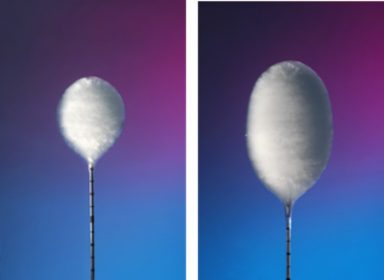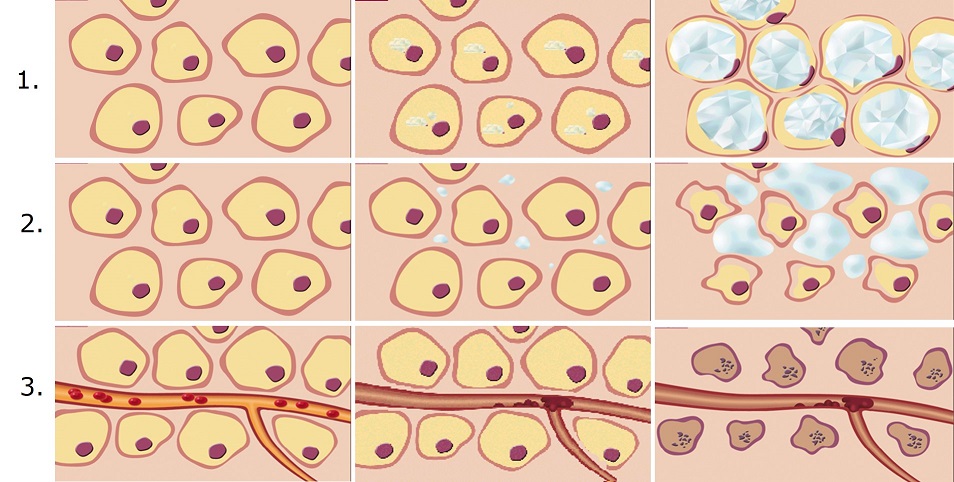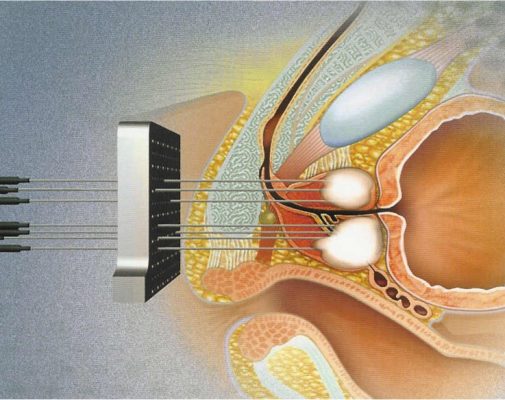Optional Treatments
Treatments > Optional Treatments > The other energies > Cryotherapy
Cryotherapy
Cryotherapy is the use of extreme cold produced by liquid nitrogen or argon gas to destroy a targeted tissue. It is based on the Joule-Thompson effect when high pressure Argon is allowed to flow through the cryoprobe [hollow needle] (picture 65), as it expands at the tip, it generates an extremely cold temperature and an ice-ball (picture 66). Cryotherapy has 3 main effects: 1) intracellular ice formation (protein denaturation), 2) extracellular ice formation and 3) ischemia (picture 67). The combination of these 3 effects leads to a tissue necrosis. Cryotherapy has various applications in the medical field from painkiller to muscular spam, oncology and Parkinson.

Picture 65 : The Joule-Thompson effect

Picture 66 : The production of iceball at the tip of cryoprobes

Picture 67: Biological effect of cryotherapy on cells and targeted tissue
Technique
Under ultrasound-guided vision, cryoprobes are placed transperineally into the prostate under general anesthesia. Once all the needles in place, the ablation protocol consists on a Freeze-thaw cycle as follows : 10mn freeze / 10mn thaw / 10mn freeze / 10mn thaw for a total ablation time of 40 minutes (picture 68). The whole procedure is monitored in real-time with a complete control of the freezing process. The goal is to reach – 40°C in the targeted zone to ensure ablation and above 0°C in zones with sensitive structures to ensure their preservation. To avoid complications the use of an urethral-warming catheter and intra-rectal warming source is necessary. The success of a procedure depends on nadir temperature, freezing duration, number of freeze-thaw cycles, and rate of thawing. In terms of safety/accuracy of the procedure the blurred lines of cooling/heating between the cryoprobes on one side and the warming disposables on the other side are one of the technical difficulties to improve in the treatment of localized prostate cancer.

Picture 68 : Sagittal view of a cryotherapy procedure with intraprostatic iceballs
Indications/Guidelines
As for HIFU, the indications of cryotherapy in prostate cancer are mainly low-risk and intermediate-risk but also selected high-risk patients (see “Clinical Scenarii”) are treated either focally or radically. Cryotherapy is proposed to naïve prostate cancer as well as in salvage situation after a radiotherapy or an HIFU failure.
Results
One of the most recent well-conducted study on a midsize population (n=122) of mainly Intermediate Risk (89%) and Low Risk (10%). At 3 years follow-up 10% of the patients needed to convert to a radical treatment, none were using pads and 84% conserved the erectile function when the patients were potent before. In this study they were no results regarding the negativation of the biopsies in the targeted area [33]. In the COLD registry published by J. Ward in 2011 on a population of 1160 patients based on a sampling of 14% of the total population who underwent prostate biopsies control 6 months after cryotherapy 74% of the patients had negative biopsies [34].


